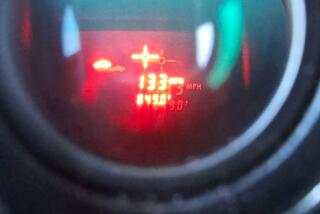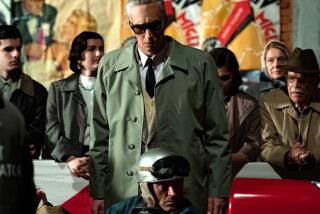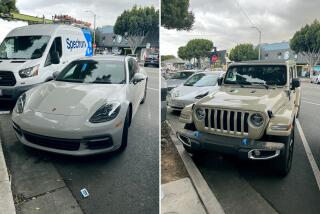Today’s Porsche 911: High tech still delivers old-school thrill
The sharp left appeared out of nowhere.
Blasting down a mountain road, surging with adrenaline, I flashed back to the first rule of driving a Porsche 911: Never let off the gas in a turn.
Unless, that is, you want to travel backward into the nearest ditch. Such are the physics of a rear-engine layout, the defining characteristic of the 911 since forever. With all that weight behind the rear axle, standing on the accelerator drops the tail into an aggressive crouch. Lifting off at the wrong moment has the opposite effect — separating the rear tires from terra firma.
For much of its storied history, the 911 earned a reputation as a bit of a handful.
PHOTOS: Porsche’s 911 through the years
“There was a time when you could drive down a mountain road and see 911s in the weeds,” said Scott Oldham, editorial vice president at auto information company Edmunds.com.
But this modern 911 — now in its 50th year — has evolved into something less terrifying, if no less ferocious. Over the years, Porsche engineers have masked the car’s eccentricities with unrelenting technical advances.
Truck-length stick shifts, heavy clutches and twitchy handling have given way to an array of electronic nannies, calibrated to intervene in moments of driver duress. Simply put, this may be the easiest car on Earth to drive fast.
Entering that treacherously tight mountain curve, somewhere east of San Diego, I kept my right foot planted and yanked the wheel left. My co-pilot, an old college buddy, snickered a bit as his right shoulder slammed into the leather-stitched door panel. But we otherwise surged into the straightaway with zero drama.
Even with 400 horsepower on tap, and that bestial roar from the rear-mounted flat-six, it’s difficult to frighten yourself in this car.
The sticker price did manage to shock: $153,560 for the 2013 Carrera 4S Cabriolet we tested. And that’s not even the most expensive 911 these days. The turbo model starts at $181,100, well into Aston Martin territory and gaining on Ferrari.
The 911 started life as an elegant but brutally simple sports car, introduced at the Frankfurt Auto Show in Germany on Sept. 12, 1963. Among its many wonders were the four seats somehow fitted into a sensual frame that seemed built for two. At $5,995, the 911 fetched only slightly more than the Corvette of the day.
But that market position has more recently been ceded to the 911’s baby brother, the Cayman, and its convertible cousin, the Boxster. Starting at a mere $53,550, the Cayman still allows young car enthusiasts to fathom saving up for a Porsche, if only a used one, once they attain that magical age of affordable insurance.
The entry-level Porsches offer a telling engineering contrast. The automaker dumped the rear-engine layout for the two-seater Cayman/Boxster models. They are instead mid-engined, with the power plant directly behind the driver but well ahead of the rear axle. This results in a neutral weight distribution universally considered ideal for handling.
It might have made sense for Porsche engineers to move the engine on the 911 some time ago — were it not for the riot that would ignite among loyalists. The engine placement is integral to the 911’s tear-drop silhouette. That shape defines Porsche. Such sacrilege will not be tolerated.
The engine has been cheated forward a bit, however, as the wheelbase has grown. Putting more space between the axles has quietly made the 911 less rear-engined than it used to be. That little adjustment — along with the wide tires lurking under those muscle-bound wheel wells — no doubt contributes to stability in mountain hairpins.
The 911’s mercurial nature has further been checked by a pair of rocket-science systems, Porsche Dynamic Chassis Control and Porsche Torque Vectoring.
The vectoring automatically applies moderate braking to the inside rear wheel during a hard turn, thus directing more torque to the outside wheel. The dynamic control, meanwhile, features hydraulic actuators, operating independently at all four wheels, that nearly eliminate body roll.
In our Carrera 4S tester, the “4” signifies all-wheel drive. The system directs most engine torque to the rear wheels in almost all driving situations. But it transfers a measure of power to the front wheels when the back tires slip, whipping the tail back into line.
All this digital wizardry helps keep the driver on the “intended path,” as Porsche delicately puts it.
But nothing on Carrera will do more for your ham-fisted driving than the seven-speed PDK transmission, a pioneering dual-clutch automated manual that threatens to drive the stick shift to extinction. The PDK rips through shifts like sniper shots, with similar accuracy. (PDK stands for Porsche Doppelkupplungsgetriebe, in case you wondered.)
More impressive than the speed of the gear changes is their smoothness. You can hear the shifts in the sudden change of engine speed — but you can’t feel them. The drivetrain remains eerily undisturbed as it rockets toward triple-digit speeds. Even drastic downshifts — from, say, sixth to second gear — fail to upset the chassis.
Students of stick-shift driving know well the delicate art of double-clutch downshifting. You engage the clutch. Then you take the car out of gear. Then blip the throttle to make the engine revs match the intended, lower gear. Then engage the clutch again. Then, finally, make the downshift.
The PDK’s automated clutches essentially do all this for you, in nanoseconds. You can shift the PDK yourself if you want, with either wheel-mounted paddles or an upshift-downshift gate in the center console. But unless you just won the 24 Hours of Lemans, the car will shift better without your meddling.
It’s tempting to get weepy for the era of simpler, wilder Porsches, when it took wits and courage to drive them the way the Stuttgart, Germany, automaker intended. These days, any moron with money can wield a 911 with a fair amount of precision; it takes little special skill or love of driving.
And yet what’s most impressive about all the over-engineering is its seamless integration into a soulful package, one that’s faithful to the 911’s legend.
All the high technology operates in stealth mode; it never intrudes on the driver’s intimate connection with the car. If some torque somehow got transferred to this wheel or that to save me in that curve, I couldn’t tell as a broad smile spread across my face and a deep breath filled my chest. The car retains a visceral, old-school feel; it simply goes where you point it.
All the technology in the Carrera 4 may well mitigate operator error. But it also offers the highest rewards for expert driving, doled out in predictable wags of that big fat tail.
“They have managed a magical balance of keeping the car feeling unique and alive — the way it kind of dances in your hands — but without having to drive it with the grip of death every time the road turns,” Oldham said. “You don’t think, ‘If I make a mistake, I may not see my kids again.’”
If Porsche stands for anything, it’s tradition. To have sculpted a sports car in the 1960s that remains instantly recognizable today is a towering achievement of design. To have preserved its core character — that intrinsic connection to the driver — elevates that tradition from science to art.







